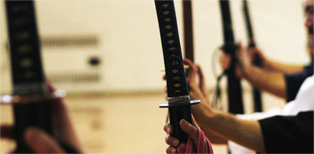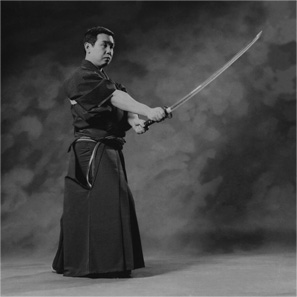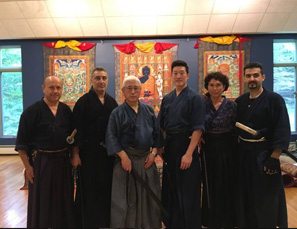KATA UNDER THE RESPECTIVE
Philosophy:
 The philosophy of the Ryushin Shouchi Ryu parallels that of most modern forms of budo, (i.e. kendo, judo, and aikido) and entails cultivating the mind and conditioning the body through rigorous training for the purpose of improving the self rather than killing an enemy. This concept is more commonly known as fudoshin (immovable mind), which refers to a state of psychological and spiritual equanimity. Based on this reasoning, the name Ryushin Shouchi Ryu was selected by the founder, Kawabata Terutaka. Ryushin means “Mind or Heart of the Willow tree,” and invokes the image of a tree which does not lose its leaves even in winter; while Shouchi can be translated as “shining wisdom.” Together, these characters convey the sense of “establishing in the world an unmovable wisdom and everyday mind by means of a strong yet flexible body and spirit.”
The philosophy of the Ryushin Shouchi Ryu parallels that of most modern forms of budo, (i.e. kendo, judo, and aikido) and entails cultivating the mind and conditioning the body through rigorous training for the purpose of improving the self rather than killing an enemy. This concept is more commonly known as fudoshin (immovable mind), which refers to a state of psychological and spiritual equanimity. Based on this reasoning, the name Ryushin Shouchi Ryu was selected by the founder, Kawabata Terutaka. Ryushin means “Mind or Heart of the Willow tree,” and invokes the image of a tree which does not lose its leaves even in winter; while Shouchi can be translated as “shining wisdom.” Together, these characters convey the sense of “establishing in the world an unmovable wisdom and everyday mind by means of a strong yet flexible body and spirit.”
Kawabata Terutaka
 Kawabata Terutaka was born in Tokyo in 1940. His interest in Japanese swordsmanship began in his early childhood when his grandfather gave him a sword he had purchased in San Francisco. Throughout his life he has made significant contributions to both the study of Japanese swords and Japanese Swordsmanship.
Kawabata Terutaka was born in Tokyo in 1940. His interest in Japanese swordsmanship began in his early childhood when his grandfather gave him a sword he had purchased in San Francisco. Throughout his life he has made significant contributions to both the study of Japanese swords and Japanese Swordsmanship.
Kawabata began his swordsmanship training in his early twenties at the Sogo Budo Shobukan, which was founded in 1963 by his father and was under the guidance of Ueno Yasuyuki Genshin (1913-1973) the headmaster of the Tenshinsho Jigen Ryu at that time. Tenshinsho Jigen Ryu is a school of swordsmanship which has its origins in Katori and Kashima, dating back to the Sengoku Jidai (Warring States Period).
Kawabata would eventually spread his knowledge of Japanese swordsmanship through the International Martial Arts Congress (Kokusai Budoin) and the International Martial Arts Federation (IMAF) (Kokusai Budo Renmei). Through IMAF, he was sent abroad to Europe and the United States to spread his school of swordsmanship. He served in the successive posts of director and vice-director, and as the sectional chief of the Kobudo division. In 1975, Kawabata taught at the NRC (currently the Nihon Zaidan) dojo in Akasaka. He also trained many students at the ANA Haneda dojo and the Yokohama Municipal Fire Station. He later opened the Seiseikan dojo on the ground floor of the Sankei Indoor Sports Akabane at Akabane Minami, Kita-ku, Tokyo in the early 2000s.
An example of Kawabata’s proficiency as a sword master was demonstrated in 1987 when he appeared on the TBS television program Chikyu Roman Yomigaeru Hiken/ Sengoku Kabutowari. In this program, Kawabata cut a gash measuring 12 cm. (nearly 4 sun) through a steel helmet called oki tenugui gata (a helmet with almost vertical sides and top plates which are extended rearwards) using a sword made by Yoshihara Yoshindo. The helmet-splitting technique had not been performed successfully since Sakakibara Kenkichi, the hanshi of the Choku Shinkage Ryu, demonstrated it before Emperor Meiji in the autumn of 1886, over 100 years before. It was around this time that he also received the Martial Arts Meritorious Award (Budo Korosho), considered the highest honor in the world of martial arts.
In addition to his training in swordsmanship, Kawabata also specializes in the collection and study of Japanese swords and their fittings. He subsequently became an executive of the Nihon Bijutsu Token Hozon Kyokai (NBTHK) (Society for the Preservation of Japanese Swords) and is known as one of their experts. Kawabata has also contributed to the founding of the Nihonto Bunka Shinko Kyokai (Association for the Promotion of Japanese Sword Culture), an organization whose intention is to perform various activities to promote Japanese art and culture to generate public interest.
Currently, Kawabata serves as the head of the Seiseikan and adviser to the soke. He continues to play an active role in various fields, and has been awarded the Medal of Honor Yellow Ribbon (awarded to individuals who, through their diligence and perseverance while engaging in their professional activities, became public role models) and the Medal of Honor Blue Ribbon (awarded to individuals who have made significant achievements in public welfare or public service) by the Government of Japan for his contributions.
Yahagi Kunikazu
 ahagi Kunikazu, the second headmaster (soke) of Ryushin Shouchi Ryu, was born in Kastsushika-ku, Tokyo in 1948. As a child, Yahagi was inspired by his grandfather, whom he visited regularly, and who had 2 sets of antique kendo bogu (armor) on display in his home. Yahagi was introduced to kendo by his uncle at the age of 10 and commenced his kendo training in elementary school. He also trained in Judo from the age of 12, an art in which he later went on to earn the rank of 2 DAN at the Kodokan. He would continue his martial studies through his formative years, and at the age of 30, he entered the NCR dojo (now the Nihon Zaidan Building) in Akasaka, Minato-ku, Tokyo, which was then under the authority of Kawabata. After nearly 30 years of diligent training under the tutelage of Kawabata, Yahagi was licensed by the International Martial Arts Federation (IMAF) as a Kobudo Hanshi 8 DAN and later succeeded in becoming a director for IMAF. This would mark the beginning of Yahagi’s international teaching career. In 2008 Yahagi became the second headmaster of the Ryushin Shouchi Ryu.
ahagi Kunikazu, the second headmaster (soke) of Ryushin Shouchi Ryu, was born in Kastsushika-ku, Tokyo in 1948. As a child, Yahagi was inspired by his grandfather, whom he visited regularly, and who had 2 sets of antique kendo bogu (armor) on display in his home. Yahagi was introduced to kendo by his uncle at the age of 10 and commenced his kendo training in elementary school. He also trained in Judo from the age of 12, an art in which he later went on to earn the rank of 2 DAN at the Kodokan. He would continue his martial studies through his formative years, and at the age of 30, he entered the NCR dojo (now the Nihon Zaidan Building) in Akasaka, Minato-ku, Tokyo, which was then under the authority of Kawabata. After nearly 30 years of diligent training under the tutelage of Kawabata, Yahagi was licensed by the International Martial Arts Federation (IMAF) as a Kobudo Hanshi 8 DAN and later succeeded in becoming a director for IMAF. This would mark the beginning of Yahagi’s international teaching career. In 2008 Yahagi became the second headmaster of the Ryushin Shouchi Ryu.
In addition to his Ryushin Shouchi Ryu training, Yahagi continues his studies in Kendo and currently holds the rank of Kyoshi 7 DAN from the All Japan Kendo Federation. Yahagi believes that Kendo is an essential component to the proper training of Ryushin Shouchi Ryu as it serves as a means to train the psychological and practical applications of the school. He believes that through the diligent training of Kendo, one can develop the true spirit and mindset long lost from times past that are necessary for the proper practice of kata.